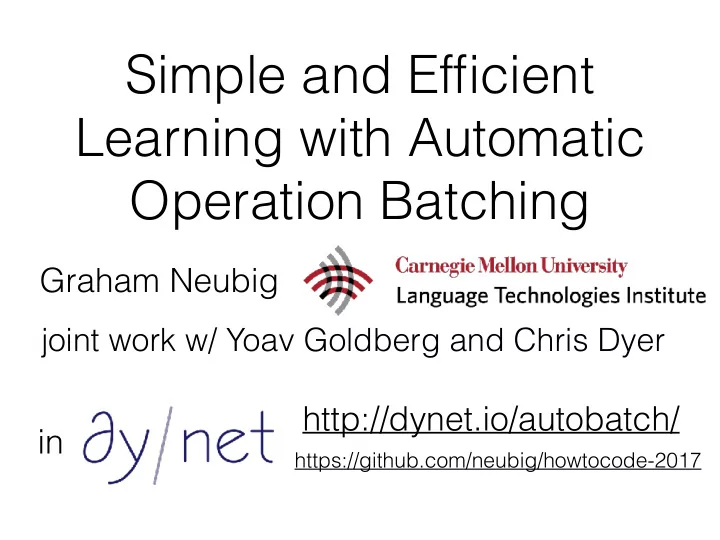

Simple and Efficient Learning with Automatic Operation Batching Graham Neubig joint work w/ Yoav Goldberg and Chris Dyer http://dynet.io/autobatch/ in https://github.com/neubig/howtocode-2017
Neural Networks w/ Complicated Structures Words Sentences S VP VP PP NP Alice gave a message to Bob Phrases Dynamic Decisions a=1 a=1 a=2
Neural Net Programming Paradigms
What is Necessary for Neural Network Training • define computation • add data • calculate result ( forward ) • calculate gradients ( backward ) • update parameters
Paradigm 1: Static Graphs (Tensorflow, Theano) • define • for each data point: • add data • forward • backward • update
Advantages/Disadvantages of Static Graphs • Advantages: • Can be optimized at definition time • Easy to feed data to GPUs, etc., via data iterators • Disadvantages: • Difficult to implement nets with varying structure (trees, graphs, flow control) • Need to learn big API that implements flow control in the “graph” language
Paradigm 2: Dynamic+Eager Evaluation (PyTorch, Chainer) • for each data point: • define / add data / forward • backward • update
Advantages/Disadvantages of Dynamic+Eager Evaluation • Advantages: • Easy to implement nets with varying structure, API is closer to standard Python/C++ • Easy to debug because errors occur immediately • Disadvantages: • Cannot be optimized at definition time • Hard to serialize graphs w/o program logic, decide device placement, etc.
Paradigm 3: Dynamic+Lazy Evaluation (DyNet) • for each data point: • define / add data • forward • backward • update
Advantages/Disadvantages of Dynamic+Lazy Evaluation • Advantages: • Easy to implement nets with varying structure, API is closer to standard Python/C++ • Can be optimized at definition time (this presentation!) • Disadvantages: • Harder to debug because errors occur immediately • Still hard to serialize graphs w/o program logic, decide device placement, etc.
Efficiency Tricks: Operation Batching
Efficiency Tricks: Mini-batching • On modern hardware 10 operations of size 1 is much slower than 1 operation of size 10 • Minibatching combines together smaller operations into one big one
Minibatching
Manual Mini-batching • DyNet has special minibatch operations for lookup and loss functions, everything else automatic • You need to: • Group sentences into a mini batch (optionally, for efficiency group sentences by length) • Select the “t”th word in each sentence, and send them to the lookup and loss functions
Example Task: Sentiment very good good neutral bad very bad I hate this movie very good good neutral bad very bad I love this movie very good good neutral bad I do n’t hate this movie very bad
Continuous Bag of Words (CBOW) I hate this movie lookup lookup lookup lookup + + + = + = W bias scores
Batching CBOW I love that movie I hate this movie lookup lookup lookup lookup + + +
Mini-batched Code Example
Mini-batching Sequences this is an example </s> this is another </s> </s> Padding Loss 1 1 1 1 1 � � � � � 1 1 1 1 0 Calculation Mask Take Sum
Bi-directional LSTM I hate this movie LSTM LSTM LSTM LSTM LSTM LSTM LSTM LSTM concat + = W bias scores
Tree-structured RNN/LSTM I hate this movie RNN RNN RNN + = W bias scores
And What About These? Words Sentences S VP VP PP NP Alice gave a message to Bob Phrases Dynamic Decisions a=1 a=1 a=2
Automatic Operation Batching
Automatic Mini-batching! • Innovatd by TensorFlow Fold (faster than unbatched, but implementation relatively complicated) • DyNet Autobatch (basically effortless implementation)
Programming Paradigm Just write a for loop! for minibatch in training_data: loss_values = [] for x, y in minibatch: loss_values.append(calculate_loss(x,y)) loss_sum = sum(loss_values) loss_sum.forward() loss_sum.backward() trainer.update() Batching occurs here
Under the Hood • Each node has “profile”, same profile → batchable • Batch and execute items with their dependencies satisfied
Challenges • This goes in your training loop: must be blazing fast! • DyNet’s C++ implementation is highly optimized • Profiles stored as hash functions • Minimize memory allocation overhead
Synthetic Experiments • Fixed-length RNN → ideal case for manual batching • How close can we get?
Real NLP Tasks • Variably Lengthed RNN, RNN w/ character embeddings, tree LSTM, dependency parser
Let’s Try it Out! http://dynet.io/autobatch/ https://github.com/neubig/howtocode-2017
Recommend
More recommend